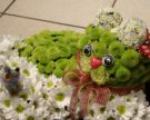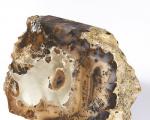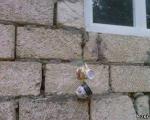Frosty pattern on glass. Winter patterns on glass drawn by frost
Every winter you can see the magnificent patterns created by the frost on the windows. They are very diverse and intricate, mysterious and simply magnificent.
How are ice patterns formed on glass?
The indoor air is much warmer than outside, and the humidity is lower. But near glass, sometimes the temperature can be below the dew point, that is, the value when steam begins to condense into dew. Small ice crystals form and ice patterns appear on the window.
Why are ice patterns always different?
Because the conditions inside the room and outside are changeable: temperature, humidity, pressure, wind speed. Even the thickness of the glass and its cleanliness play a role.
At first Frost patterns are formed on the surface of the glass, and when their thickness becomes so large that the transfer of heat to the outside slows down, then the ice patterns begin to grow in thickness.
“Vegetable” patterns appear with high humidity and a gradual decrease in temperature. First, the glass becomes wet, and then the moisture freezes, forming bizarre “thickets.” The process starts from the bottom of the glass because more water collects there. Yes, and the pattern there is larger, and towards the top it becomes smaller.
If the cooling process was fast, and the moisture did not have time to flow down the glass, then the “woody” pattern throughout the window will be the same size.
Window glass cannot be perfectly even and smooth; they almost always have small defects and scratches. They contribute to the formation of another frosty pattern. First, ice crystals appear along the scratch, forming a strip, and then curved stems begin to branch off from it.
Since frosty patterns on the window appear when certain conditions are met, it means that if you change them, the glass will remain clean. Reduce the air humidity or prevent the glass from cooling too much (make the window well insulated) and Frost will not draw anything on your window.







Every winter you can see the magnificent patterns created by the frost on the windows. They are very diverse and intricate, mysterious and simply magnificent.
How are ice patterns formed on glass?
The indoor air is much warmer than outside, and the humidity is lower. But near glass, sometimes the temperature can be below the dew point, that is, the value when steam begins to condense into dew. Small ice crystals form and ice patterns appear on the window.
Why are ice patterns always different?
Because the conditions inside the room and outside are changeable: temperature, humidity, pressure, wind speed. Even the thickness of the glass and its cleanliness play a role.
First, frost patterns form on the surface of the glass, and when their thickness becomes so large that the transfer of heat to the outside slows down, the ice patterns begin to grow in thickness.
“Vegetable” patterns appear with high humidity and a gradual decrease in temperature. First, the glass becomes wet, and then the moisture freezes, forming bizarre “thickets.” The process starts from the bottom of the glass because more water collects there. Yes, and the pattern there is larger, and towards the top it becomes smaller.
If the cooling process was fast, and the moisture did not have time to flow down the glass, then the “woody” pattern throughout the window will be the same size.
Window glass cannot be perfectly even and smooth; they almost always have small defects and scratches. They contribute to the formation of another frosty pattern. First, ice crystals appear along the scratch, forming a strip, and then curved stems begin to branch off from it.
Since frosty patterns on the window appear when certain conditions are met, it means that if you change them, the glass will remain clean. Reduce the air humidity or prevent the glass from cooling too much (make the window well insulated) and Frost will not draw anything on your window.







Drawings on glass are fun, beautiful and festive. Having done this with children Christmas decoration on all the windows in your apartment, you will not only give festive mood to yourself, and to all those who, passing by your house, glance at your windows. And it’s also beautiful and very affordable way, so that and .
New Year's drawings on windows: draw with toothpaste
Drawings on windows made with regular toothpaste are the simplest and most cost-effective way that kids will really like, and you won’t have to worry about how to clean the windows, because the paste washes off well with water. There are two ways to draw with toothpaste on glass.
To create on a window, you will need:
- sponge for washing dishes;
- toothpaste white;
- water;
- Bowl;
- scotch;
- stencils of New Year's drawings;
- toothpicks.

Roll up a piece of sponge and secure it with tape. Squeeze into a bowl toothpaste and dilute it a little with water. Dip the resulting “brush” into the paste and draw patterns on the glass with it. You can paint with or without stencils. After the paste has dried a little, use a toothpick to draw in the details. And with a thin brush you can draw threads for toys.
For the next method of drawing with toothpaste on glass, you will need slightly different materials:
- toothpaste;
- water;
- old toothbrush;
- stencils.
This method is often used to decorate not only windows, but also mirrors in the house for the New Year. To begin, select design stencils. These can even be ordinary snowflakes cut out of paper. , you will find it at the link. Moisten the cut out stencil with water and glue it to the surface of a window or mirror. Remove excess moisture with a dry cloth.

In a container, dilute the toothpaste with water until smooth. Apply the mixture generously to the brush and bring it close to the stencil. Run your fingers along the bristles, thus sprinkling the paste onto the stencil of New Year's drawings until you completely fill the drawing.

Leave the drawing along with the stencil until almost completely dry. When the winter drawing is ready, paper stencil easy to separate from glass surface and at the same time the drawing itself will not be blurred.
What else to draw on windows: techniques for New Year's patterns on glass
For drawings on glass for the New Year, special washable paints for painting on glass, gouache with a brush, artificial snow in a can, regular soap, PVA glue and glitter.




Drawings on windows for the New Year 2019: stencils and templates
To make New Year's drawings on windows neat, it is better to use stencils and templates. You just need to choose the scene you like, download the picture to your computer, print it and cut it out along the outline and in the required designated places. And then everything is as described above in the master class to draw with toothpaste on the windows.










How to paint windows for the New Year: 13 ideas for New Year's drawings on glass
We offer you several options for what you can draw on the windows in winter. Such pictures from New Year's drawings You can look at the windows for hours and be inspired by these wonderful ideas.













Christmas tree, decorated, hung around the house, “frost patterns” on the windows, painted with my own hands- all this will create a feeling of miracle and the approaching New Year 2019.
The holiday atmosphere and solemn mood largely depend on the decor and interior. That is why decorating your home before certain holidays has long become a tradition.
This is not only a way to make the interior special, but also to bring the whole family together for common occupation.
Creating a New Year's mood
One of the most long-awaited holidays is New Year. Every home is transformed. Appears traditional Christmas tree, garlands, figures of Father Frost and Snow Maiden.
One of the ways to create a festive and fabulous atmosphere is the application of frosty patterns on windows.
This is not at all difficult to do; there are many ways to create such decor. In addition, all family members can take part in the process.
Preparing to decorate windows with patterns
Before you get started, you need to prepare. Depending on the method of creating and applying frosty patterns on windows, you may need:
- Paper.
- Scissors.
- Stationery knife.
- PVA glue.
- Paint brush.
- A small sponge.
- Toothbrush.
- Toothpaste.
- Soap.
- A little glitter if desired.
It is absolutely not necessary to arm yourself with all this without exception. In some cases, 2 - 3 elements from this list are enough.
Methods for applying patterns to windows
IN in this case Several options are possible.

It is not necessary to choose one of the methods. They can be combined very well.
The process of creating a frosty pattern on a window with your own hands
The technique of applying a pattern to glass directly depends on the skills and wishes of the creator:

This method is perfect for those who have required skills in drawing.
- When using frost patterns on a window, you can also use a brush. You can use it to paint the slots completely, in a dense layer. Then the drawing will be clear and drawn.
- If you want to get a more delicate image as a result, you can dilute white toothpaste with a small amount of water. Dip into the resulting mixture toothbrush. And then run your finger along the bristles, creating splashes and directing them onto the glass.
You must continue until the pattern is completely formed. You can apply the mixture in several layers until the color becomes more saturated.
- The same toothpaste mixture can be applied using a sponge. It needs to be dipped in toothpaste diluted with water. It is advisable to remove excess mixture to avoid drips.
Then apply the sponge to the glass, as if blotting. The result is translucent ornate traces, which will become frosty patterns on the window.

Using the same principle, you can use a solution of water with gelatin, and instead of “snow”, ordinary salt.
As can be seen from the description, the process is not complicated. If you have no experience at all in drawing and home creativity, then there is nothing wrong with using drawings and images from the Internet.
Templates for patterns
Patterns are most often used to decorate window glass. With their help, you can create almost any design that will look beautiful and neat.
Many ready-made templates can be found on the Internet. All you need to do is print them, cut them out and use them for their intended purpose.

But you can do all this yourself. To do this, you need to think through the entire composition: what size the pattern will be, in what part of the window it will be, etc.
This will help you decide what size it should be. paper sheet. Now you can apply the drawing. It is advisable to do this with a simple pencil so that you can correct it.
When the drawing is ready, you can start cutting. Ready template can be attached again Right place to make sure it is as intended.

The stencil (or template) is easier to use when it doesn't move. To do this, you can moisten the paper in a soapy solution and apply it to the window.
Now we draw frosty patterns on the window, filling all the cutouts in the template with white flowers. Once the paper is dry, it will not be difficult to remove it from the glass. The template lends itself easily and does not spoil the drawing in any way.
The advantage of a template is that it can be reused many times. In this case, the frosty pattern is repeated in exactly the same way as many times as necessary.
It is very comfortable. For example, if you need to decorate several windows of the same room. Or the composition, as planned, is repeated on all the windows of the house.
Vytynanka on the windows
This is one of the very interesting ways glass decorations. The frosty patterns on the windows are a separate design or composition cut out of white paper.
This method of decoration requires thorough preparation. It will take more time to draw and cut. Then all that remains is to fix it all on the glass.
As with templates, you can find ready-made drawings. Or show your imagination and apply the pattern to paper yourself.

This type of creativity has its own characteristics. Therefore, novice craftsmen are recommended to first make a small drawing to understand the principle of operation. Especially if a ready-made solution is not used.
Protrusions on windows usually look brighter because they are clearly defined.
Ideas for drawings on windows
A variety of images can be applied to glass. For example, large and ornate patterns that will completely fill the space window glass. Or small neat drawings that are located only in the corners of the windows.
Also, the drawing can have clear boundaries and be completely painted over. Or it will be a light translucent pattern.

Often applied to glass White background from splashes. And then they paint on top with white paint or paste using a brush. The process is more labor-intensive, but everything looks very beautiful.
Or you can draw on the same white background reverse side brushes In this case, part of the applied composition is erased from the glass and a pattern in the form of transparent lines on a white background remains.
Can be used own ideas or be inspired by photos of frosty patterns on windows.
Painting patterns on windows with children
Children enjoy taking part in the process of decorating the house. Drawing frosty patterns on the window is no exception. At the same time, the process perfectly develops imagination and fine motor skills hands
If the child is old enough and can use scissors on his own, then you should let him use his imagination and create a template (or draw a picture) on his own.

If very young children are involved in the process, then they cannot do without the help of their elders. It should be borne in mind that out of curiosity, children often try to taste the “frost pattern”.
In this case, it is advisable instead soap solution use sweet edible syrups (for example, sugar dissolved in water). AND powdered sugar instead of "snow".
To ensure that the frosty patterns on the windows turn out beautiful and the application process does not cause any trouble, it is advisable to follow some recommendations:
- Clean the glass surface well first. This will help the drawing lie flat and last for a long time.
- Smudges or errors in the image are easily erased from the glass. So the drawing can be corrected at any stage of creation.
- It is better to attach frosty paper patterns to the window using a soap solution. PVA glue will take longer and be more difficult to wash off.
- Small and complex details of the design are easier to cut out using stationery knife.
- When using a utility knife for cutting, it is recommended to place a wooden board under it to avoid damaging the surface of the table.
- The entire process from start to finish can take quite a long time. It is recommended to think through and prepare templates, patterns and everything you need in advance. And then devote separate time to applying it to the windows. Thus, this activity will not get boring and will only bring pleasure from joint creativity.
- If the composition is conceived very big size, then you can compose it from fragments. Especially if it is a template or a protrusion. Very large images are difficult to cut and attach.



